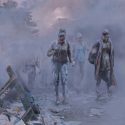Waves that travel across the ocean as fast as a jet. They are 30 m (100 ft) tall. And can uproot trees and move houses. So why do people always think they can outrun them? Tsunamis are caused by extreme underwater motion that can be caused by earthquakes or volcanoes.
This results in massive waves that can crash into coastal cities and cause critical damage to buildings and roads. In 2004, the Indian Ocean tsunami killed an estimated 230,000 people in over a dozen countries, all in just a few hours. This demonstration of lethal power shook the world, while exposing a lack of proper warning systems and general unawareness of the signs of an impending tsunami.
But in 2011, a well-prepared Japan was hit by a tsunami. 16,000 people were killed. Seawalls and modern tsunami-resistant buildings likely saved thousands of lives, but couldn’t save them all. A prepared community is a good first step to survive a tsunami, but you need to do your part as well. Why should a whistling sound scare you? Is staying inside your car a bad idea? And why shouldn’t you go straight home after a tsunami hits?
Today we want you to avoid the mistakes that could kill you in case of a tsunami occurring near you.
Here’s what you should not do.
Number 6. Do not be too curious
You’re at the beach when the waters suddenly recede. You better follow the water and investigate, right? WRONG. Don’t start walking further out from the shore. Doing so means putting yourself too close to the impending action. It’s hard to interpret the speed of a wave when you are on the beach, and when you get too close, you lose your perspective.
When you finally realize its size and speed, it will be too late. You’ll be overtaken by the enormous wave. But not all tsunamis will have receding water, so how else can you tell if you’re in danger?
Number 5. Do not ignore the signs
It’s common for there to be emergency centers that specialize in detecting and alerting people about impending tsunamis. If you’re in a coastal city and feel an earthquake, prepare to get further inland and stay alert. Keep a smartphone or radio close to learn about any announcements. If a tsunami watch is issued, make sure you and your family are prepared to evacuate. If a tsunami warning is issued, get moving. Immediately. You may also hear a noise like a plane, or whistling. This is another cue to get out of there!
Number 4. Don’t waste time
Once a tsunami warning is issued, you have a maximum of 30 minutes to get to safety. But don’t take this for granted. It doesn’t always take that long for a tsunami to reach shore. Sometimes it could only be a few minutes or even seconds before a wave washes you away. If you are driving and become stuck in a traffic jam, get out of the car and run to higher ground.
The waves can include uprooted trees or even boulders, so your vehicle might not be able to save your life. This deadly natural disaster can flood as far as 10 km (6 mi) inland within approximately six minutes. Outrunning the tsunami is not an option. Find a building and climb to at least the third floor. Hide somewhere away from windows. A large hotel with several stories would be ideal.
Number 3. Do not return too fast
Never leave your house or shelter while the tsunami is happening. And do not return to low-lying areas after the first wave. Tsunamis generate multiple waves, and the first wave is not always the biggest. A small wave might be 2 m (6.5 ft) and would carry more than enough force to knock you down.
Following a March 11, 2011 earthquake in Japan, a tsunami hit the Northern California coast. After the major wave had hit, a man named Dustin Douglas Weber came back to take pictures and got swept up in a second wave. Three weeks later, his body washed up at Fort Stevens State Park in Oregon, 483 km (300 mi) away.
Number 2. Do not go straight home after
Remain on higher ground for at least three hours, or until authorities announce that it is safe to return to low-lying areas. Bridges may be compromised and collapse, so take alternate routes to go home. If your house is flooded, stay away. It could collapse when you get inside. Before reentering, your home must be checked for gas leaks, fires and electrical hazards. Even if your house seems unaffected, don’t drink tap water until it’s been tested for contamination.
Number 1. Do not lower your guard
It’s been a long and traumatic day, but it might not be over. Do not underestimate the potential for secondary disasters like landslides or aftershocks. Prepare a disaster kit with first aid supplies, drinking water and enough food to last for at least three days. You survived thanks to your city’s safety protocols and quickly identifying the signs of an impending tsunami.
But the devastating power of water can cause damage even far from the coast. What if the dam that protects your city suddenly collapses?
Sources
- ” During A Tsunami “. 2018. Getprepared.Gc.Ca.
- “Tsunami: Do’S & Don’Ts | NDMA, Goi“. 2022. Ndma.Gov.In.
- “No, You Can’t Outrun A Tsunami”. 2013. Livescience.Com.
- “THINGS YOU SHOULD KNOW ABOUT TSUNAMIS” 2022. Smgov.Net.
- “Tsunamis“.Help, How, Emergencies Canada, and Types Emergencies. 2022. Red Cross Canada.

















